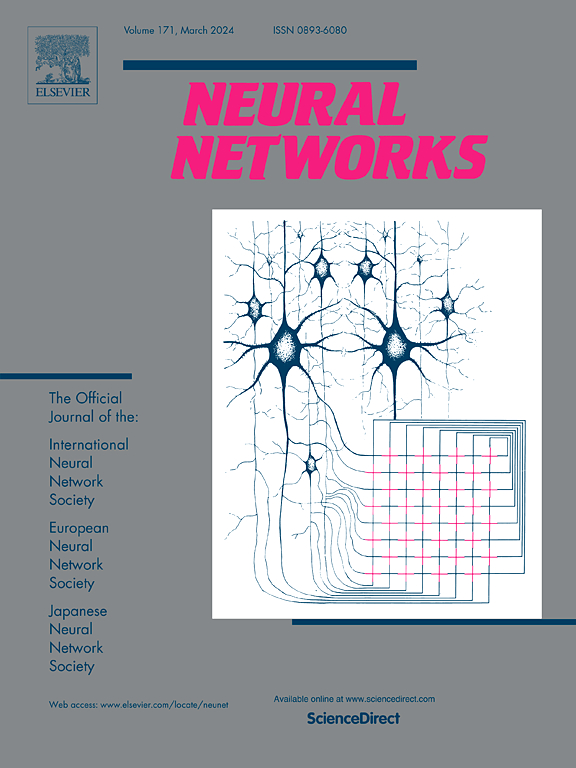Learning personalized drug features and differentiated drug-pair interaction information for drug–drug interaction prediction
IF 6
1区 计算机科学
Q1 COMPUTER SCIENCE, ARTIFICIAL INTELLIGENCE
引用次数: 0
Abstract
Multi-drug combination therapies are increasingly used for complex diseases but carry risks of harmful drug interactions. Effective drug–drug interaction prediction (DDIP) is essential for assessing risks among numerous drug pairs. Most DDIP methods involve two main steps: drug representation and drug pair interaction extraction, respectively challenged by the loss of personalized drug information and the need for differentiated interaction data, and are rarely studied. Specifically, personalized drug information refers to the distinct features of each drug. These properties can be easily confused by neighboring information during graph propagation. This issue is especially prominent in drug interaction graphs with long-tail distributions, which poses challenges for personalized drug information learning. Furthermore, it is crucial to learn interactions with differentiation in order to identify diverse drug relationships. Some methods simply concatenate drug features, often ignoring the differences of different drug relationships, while other methods based on substructures rely on professional pharmacological knowledge and are computationally complex. To address these issues, we propose a novel method, learning personalized Drug Features and differentiated Drug-Pair interaction information for drug–drug interaction prediction (DFPDDI). This approach employs a contrastive learning network with edge-aware augmentations and mutual information estimators to capture personalized drug features across various graph distributions. Furthermore, it applies a mutual information constraint to drug-pair representations, enhancing the accuracy of interaction predictions by better distinguishing between different types of drug relationships. The results evaluated on three public datasets demonstrate competitive performance compared to baselines. It also shows potential for accurate predictions, particularly in imbalanced-distribution graphs.
学习个性化药物特征和差异化药物配对相互作用信息,用于药物相互作用预测
多种药物联合疗法越来越多地用于复杂疾病的治疗,但也存在有害药物相互作用的风险。有效的药物相互作用预测(DDIP)对于评估众多药物配对之间的风险至关重要。大多数 DDIP 方法涉及两个主要步骤:药物表征和药对相互作用提取,分别面临个性化药物信息丢失和需要差异化相互作用数据的挑战,很少有人对此进行研究。具体来说,个性化药物信息指的是每种药物的不同特征。在图传播过程中,这些特性很容易被相邻信息混淆。这一问题在具有长尾分布的药物相互作用图中尤为突出,这给个性化药物信息学习带来了挑战。此外,为了识别多样化的药物关系,学习差异化的交互作用至关重要。有些方法只是简单地连接药物特征,往往忽略了不同药物关系的差异,而其他基于子结构的方法则依赖于专业的药理学知识,计算复杂。为了解决这些问题,我们提出了一种新方法,即学习个性化的药物特征和差异化的药物配对相互作用信息来进行药物相互作用预测(DFPDDI)。这种方法采用了对比学习网络与边缘感知增强和互信息估计器,以捕捉各种图分布中的个性化药物特征。此外,它还将互信息约束应用于药物对表征,通过更好地区分不同类型的药物关系来提高相互作用预测的准确性。在三个公共数据集上评估的结果表明,与基线相比,该方法的性能极具竞争力。它还显示了准确预测的潜力,尤其是在不平衡分布图中。
本文章由计算机程序翻译,如有差异,请以英文原文为准。
求助全文
约1分钟内获得全文
求助全文
来源期刊

Neural Networks
工程技术-计算机:人工智能
CiteScore
13.90
自引率
7.70%
发文量
425
审稿时长
67 days
期刊介绍:
Neural Networks is a platform that aims to foster an international community of scholars and practitioners interested in neural networks, deep learning, and other approaches to artificial intelligence and machine learning. Our journal invites submissions covering various aspects of neural networks research, from computational neuroscience and cognitive modeling to mathematical analyses and engineering applications. By providing a forum for interdisciplinary discussions between biology and technology, we aim to encourage the development of biologically-inspired artificial intelligence.
 求助内容:
求助内容: 应助结果提醒方式:
应助结果提醒方式:


